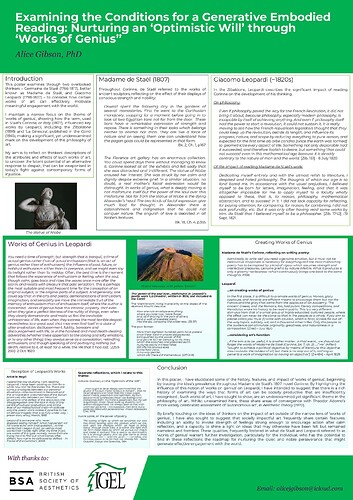 Speaker: Alice Gibson @al1ceg1bs0n
Speaker: Alice Gibson @al1ceg1bs0n
 Affiliation: Independent
Affiliation: Independent
 Co-authors: Judith Brottrager & Thomas Weitin
Co-authors: Judith Brottrager & Thomas Weitin
Title: ‘Works of Genius’: a Tool for Nurturing an Optimistic Will?
Abstract: This poster examines aesthetic theory which considers how works of art such as poetry can seek to bring readers out of inertia and foster a state of enthusiasm to engage with the world and invoke feelings that promote positive activity attending to a known problem or crisis, such as the environmental crisis. This poster will consider the trajectory of the theme of what the poet-philosopher Giacomo Leopardi called ‘works of genius’ in relation to Antonio Gramsci’s consideration of the optimism of the will and bring this to bear on the strengths of poetry, as considered today.
 Long abstract
Long abstract
Antonio Gramsci wrote in his Prison Notebook (1929): [A] man ought to be so deeply convinced that the source of his own moral forces is in himself … that he never despairs and never falls into those vulgar, banal moods, pessimism and optimism. My own state of mind synthesizes these two feelings and transcends them: my mind is pessimistic, but my will is optimistic. Since I never build up illusions, I am seldom disappointed. I’ve always been armed with unlimited patience – not a passive, inert kind, but a patience allied with perseverance. Of Gramsci’s insight, the cultural theorist Stuart Hall reflected on the increasing difficulty of adopting such a stance in modern life, commenting: Optimism of the intellect, pessimism of the will. That it is increasingly difficult if undeniable, and also that the difficulties now operate on such a large scale; you know, when one talks about global forces, it seems almost they occupy the full stage, as it were, of one’s awareness… I think we are always, always working on the mess. A similar thought has also previously been expressed by Rudyard Kipling in his 1910 poem ‘If’, where he considered the value of treating ‘Triumph and Disaster’- ‘those two imposters’ - just the same. In both Kipling and Gramsci’s thought, the authors consider the value of adopting a stance that protects us against disappointment, or being swayed by the daily chance events that may too easily distract us from our greater purposes, while Hall’s reflection speaks to the increasingly narrow opportunities to protect a scared space in which to develop such approaches. One meaningful contribution to a way in which we may work to stay in alignment with a bigger purpose is in the work of the overlooked 19th century poet-philosopher Giacomo Leopardi, who borrowed the term ‘works of genius’ from Madame de Staël’s novel Corrine (1807), where Staël gave an account of the nobility found in the conscious strength portrayed in the stance of two ancient Egyptian statues of lions settled at the foot of the Cordonata in Rome and the equestrian statue of Marcus Aurelius on the Capitoline Hill in Rome. For both Leopardi and Staël, these statues embodied true nobility and peacefulness, standing as ‘the true image of tranquility in strength’. Inspired by Staël, Leopardi developed his own ‘work of genius’ and reflected on the power of a strength that is calm in his extensive tome the Zibaldone in early October 1820: You need a time of strength, but a strength that is tranquil, a time of actual genius rather than of actual enthusiasm (that is, an act of genius rather than of enthusiasm), the influence of past, future, or habitual enthusiasm rather than its presence, and we might even say its twilight rather than its midday. Often, the best time is the moment that follows the experience of enthusiasm or feeling, when the soul, though calm, goes back and rides the waves once more after the storm, and recalls with pleasure that past sensation. This is perhaps the most suitable and most frequent time for the conception of an original subject, or the original parts of a subject. [258] Extending his conclusion on the initial need for enthusiasm, from which genius could follow, Leopardi wrote of the value of socially conscious literary experiences related to enthusiasm: It is a property of works of genius that, even when they represent vividly the nothingness of things, even when they clearly show and make you feel the unhappiness of life, even when they express the most terrible despair, nevertheless to a great soul that finds itself in a state of extreme dejection, disenchantment, nothingness, boredom, and discouragement about life, or in the most bitter and deathly misfortune (whether on account of lofty, powerful passions or something else), such works always bring consolation, and rekindle enthusiasm, and, though they treat and represent nothing but death, they restore, albeit momentarily, the life that it had lost. And so, while that which is seen in the reality of things grieves and kills the soul, when seen in imitation or any other form in works of genius (e.g., in lyric poetry, which is not, properly speaking, imitation) it opens and revives the heart. [260] Here we see how, for Leopardi, while ‘works of genius’ may deal with the ‘most bitter and deathly misfortune’, they can nonetheless ‘bring consolation, and rekindle enthusiasm’, and encourage an opening and revival of the heart from which action may emerge from the most dire circumstances. Finally, the last consideration of the way in which forms of literary art can nurture environments in which an optimistic will capable of the cultivating perseverance can thrive considered in this poster will be the work of the feminist poet Audre Lorde, Sister Outsider.


